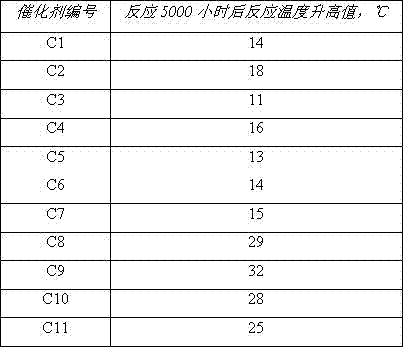Preparation method of hydrodemetallization catalyst
A technology for hydrodemetallization and catalyst, which is applied in metal/metal oxide/metal hydroxide catalysts, chemical instruments and methods, physical/chemical process catalysts, etc., and can solve problems such as unsatisfactory mechanical strength of catalysts
- Summary
- Abstract
- Description
- Claims
- Application Information
AI Technical Summary
Problems solved by technology
Method used
Image
Examples
Embodiment 1
[0031] Weigh the pore volume to 0.9ml / g, and the specific surface area to be 220m 2 100 grams of γ-phase cylindrical alumina carrier per g is put into the spray rolling pan, and in the rotating state, the carrier in the rolling pan is sprayed and impregnated with 25ml xylitol aqueous solution with a mass concentration of 40% ; Then use 40ml of xylitol aqueous solution with a mass concentration of 20% to continue to spray and impregnate the alumina carrier; finally, use 40ml of xylitol aqueous solution with a mass concentration of 10% to continue to spray and impregnate the alumina carrier. The impregnated alumina support was dried at 110°C for 8 hours. Then use 150ml containing MoO 3 10 g / 100ml (molybdenum source comes from ammonium molybdate), NiO 1.5 g / 100ml (nickel source comes from nickel chloride), urea 26 g / 100ml impregnation solution to impregnate the above carrier for 5 hours, filter out the excess solution, remove the wet agent Transfer to an autoclave and place the au...
Embodiment 2
[0033] Same as Example 1, except that the alumina carrier is in the shape of clover strips. For the first spray dipping, 30ml of sorbitol with a mass concentration of 30% was used. For the second spray dipping, 50ml of sorbitol with a mass concentration of 10% was used. For the alcohol aqueous solution, 20ml of sorbitol aqueous solution with a mass concentration of 5% was used for the third spray dipping. The active component impregnating liquid contains MoO 3 8g / 100ml (molybdenum source comes from ammonium molybdate), NiO1g / 100ml (nickel source comes from nickel chloride), urea 22g / 100ml impregnating the above carrier. During the hydrothermal treatment, firstly, it was sealed and heat-treated at 130° C. for 6 hours, and then heated to 220° C. for 10 hours to prepare the hydrodemetalization catalyst C2 of the present invention. The properties of the catalyst are shown in Table 1.
Embodiment 3
[0035] Same as Example 1, except that four times of spray dipping were used. For the first spray dipping, 20ml of mannitol with a mass concentration of 50% was used. For the second spray dipping, 40ml of sorbitol with a mass concentration of 30% was used. In the third spray dipping, 20ml of sorbitol aqueous solution with a mass concentration of 20% was used, and 20ml of sorbitol aqueous solution with a mass concentration of 10% in the fourth spray dipping. The active component impregnating liquid contains MoO 3 12 g / 100ml (molybdenum source comes from ammonium molybdate), NiO2 g / 100ml (nickel source comes from nickel chloride), urea 28 g / 100ml impregnating the above carrier. During the hydrothermal treatment, firstly, sealed and heat-treated at 120° C. for 8 hours, and then heated to 240° C., sealed and heat-treated for 6 hours to prepare the hydrodemetalization catalyst C3 of the present invention. The properties of the catalyst are shown in Table 1.
PUM
| Property | Measurement | Unit |
|---|---|---|
| specific surface area | aaaaa | aaaaa |
| water absorption | aaaaa | aaaaa |
Abstract
Description
Claims
Application Information
 Login to View More
Login to View More - R&D
- Intellectual Property
- Life Sciences
- Materials
- Tech Scout
- Unparalleled Data Quality
- Higher Quality Content
- 60% Fewer Hallucinations
Browse by: Latest US Patents, China's latest patents, Technical Efficacy Thesaurus, Application Domain, Technology Topic, Popular Technical Reports.
© 2025 PatSnap. All rights reserved.Legal|Privacy policy|Modern Slavery Act Transparency Statement|Sitemap|About US| Contact US: help@patsnap.com



